| کد مقاله | کد نشریه | سال انتشار | مقاله انگلیسی | نسخه تمام متن |
|---|---|---|---|---|
| 4269912 | 1610867 | 2014 | 12 صفحه PDF | دانلود رایگان |
IntroductionThe progress and determinants of sexual dysfunction in middle‐aged and elderly men remain unclear.AimTo describe the incidence or remission and biopsychosocial predictors of erectile dysfunction (ED) and low sexual desire (SD).Main Outcome MeasuresErectile function (International Index of Erectile Function) and sexual desire (Sexual Desire Inventory 2) were assessed at follow‐up. Sociodemographic, lifestyle, and health‐related factors were examined in multivariate models of ED and low SD.MethodsData were collected from 810 randomly selected men residing in northern and western Adelaide, Australia, and aged 35–80 years at baseline, who made clinic visits 5 years apart.ResultsAt baseline, 23.2% (n = 123) of men had ED. ED incidence and remission were observed in 31.7% (n = 179) and 29.0% (n = 71) of eligible men, respectively. At baseline, 19.2% (n = 165) had low solitary sexual desire, and 6.0% (n = 50) had low dyadic sexual desire; incidence of low sexual desire occurred in 17.6% (n = 83) (solitary) and 8.3% (n = 51) (dyadic), while remission occurred in 15.4% (n = 68) (solitary) and 22.6% (n = 40) (dyadic) of men. In the final regression models, predictors of incident ED were higher age, lower income, higher abdominal fat mass, low alcohol intake, higher risk of obstructive sleep apnea (OSA) risk, voiding lower urinary tract symptoms (LUTS), depression, and diabetes. Predictors of ED remission were lower age, current employment, and absence of voiding LUTS, angina, diabetes, and dyslipidemia. Predictors of low dyadic SD incidence included higher age, never having been married, widowhood, being unemployed, being retired, insufficient physical activity, and low alcohol intake. Predictors of low dyadic SD remission were being married, not being widowed, higher income, lower abdominal fat mass, lower OSA risk, and higher plasma testosterone. Predictors of low solitary SD included never having been married, being unemployed, low alcohol intake, lower testosterone, storage LUTS, and hypertension. Predictors of low solitary SD remission were being married, being employed, higher income, higher physical activity, moderate alcohol intake, and depression.ConclusionsSexual dysfunction in aging men is a dynamic disorder whose incidence and remission are predicted by a range of modifiable risk factors. Martin SA, Atlantis E, Lange K, Taylor AW, O'Loughlin P, Wittert GA, and members of the Florey Adelaide Male Ageing Study (FAMAS). Predictors of sexual dysfunction incidence and remission in men. J Sex Med 2014;11:1136–1147.
Journal: The Journal of Sexual Medicine - Volume 11, Issue 5, May 2014, Pages 1136–1147
